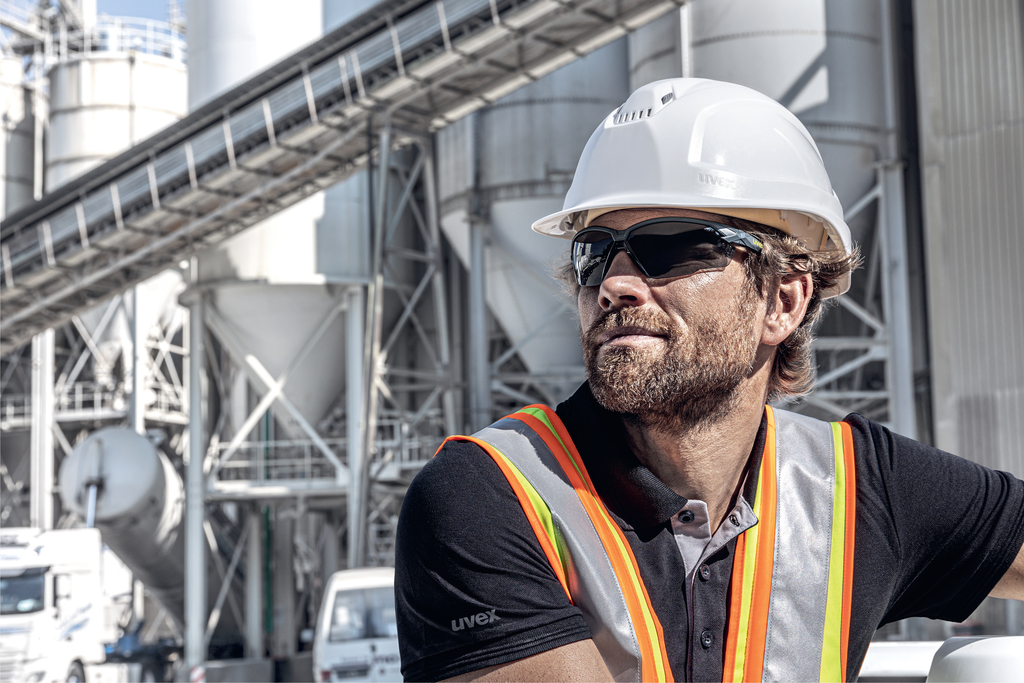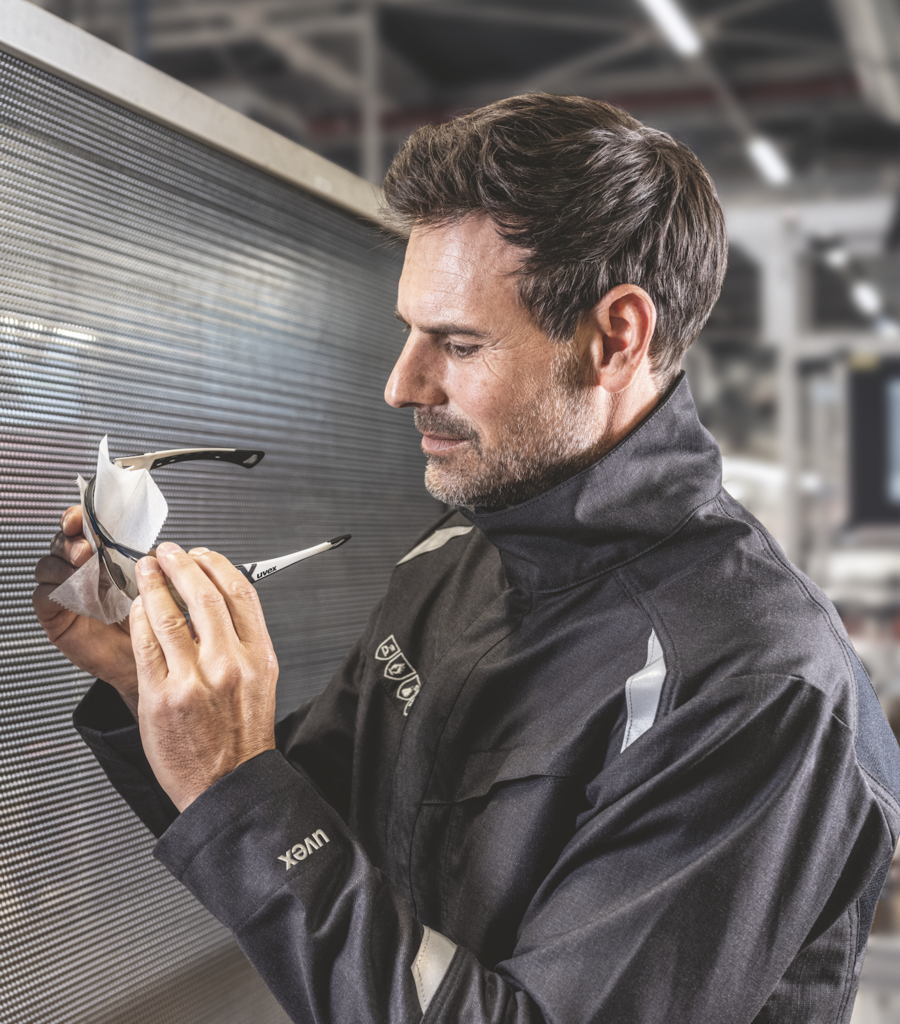
Kelly Rose
Editor

Kelly Rose
Editor
Taking good care of your eye protection has important implications for safety, cost and sustainability. Clair Weston explains how to clean and store safety spectacles to maximise their lifespan.
Occupational safety glasses are a vital part of PPE in many work environments. The eyes are among our most important – and most vulnerable – sensory organs. While eye injuries are not the most common type of injury in the workplace, they can be particularly severe and potentially lead to the loss of sight.
Safety eyewear can serve many purposes. It may protect from mechanical hazards caused by dust or microparticles; optical hazards caused by light or laser radiation; chemical hazards caused by acids, alkalis or vapours; thermal hazards caused by flames or hot liquids; and electrical hazards caused by electric arcs. If employees are exposed to hazards such as these at their workplace, wearing safety eyewear is not just recommended — it is mandatory.
Safety glasses must be tested and certified in accordance with the European or UK standard (see box) and meet special requirements that regular glasses do not. They cover a larger surface so that the eye area is completely protected. They are sturdier than normal glasses and made of lightweight plastic. Safety glasses are also equipped with special features, such as coatings or padding, that provide additional protection and extra safety.
The benefits of good maintenance
Taking good care of safety eyewear is crucial for several reasons. Failure to do so is likely to lead to scratches on the lenses, which can obscure your vision and compromise your perception of hazards, as well as causing headaches and fatigue. This can directly impact on your safety and make you more vulnerable to injuries.
If there are any signs of damage to your glasses, you should replace them. Proper maintenance will extend the lifespan of safety eyewear and reduce the frequency of replacements, saving on costs for both individuals and organisations.
Extending a product’s lifespan is important from a sustainability perspective, too. Environmental impact is becoming a growing concern for companies across all industries, to the point that some manufacturers are now providing a carbon cost for their PPE products. As well as purchasing sustainably produced eyewear, proper maintenance is vital to minimise the need for premature replacements, which use up additional materials, increase the carbon cost, and contribute to the global waste problem.
How to maintain your eyewear
The number one cause of scratched lenses is improper cleaning. You should never use clothing, paper towels, napkins or facial tissues to clean your lenses. Most of these fabrics are infused with debris and abrasive fibres, which can easily scratch the lens and affect the clarity. Always use towelettes, tissues and cleaning fluid that have been designed for use on lenses.
To get the best out of your eyewear follow these steps:
1. Rinse any dust and coarse particles off the lens under running water or use the edge of a folded moist towelette to brush away surface dust.
2. Spray a small amount of cleaning fluid onto both sides of the lens or unfolded towelette.
3. Wipe the lens inside and out in a circular motion using a lens-cleaning tissue or towelette. Do not scrub the lens backwards and forwards.
4. Do not wipe the lens dry. Instead, allow any moisture to evaporate.
Handling and storage are also vital to proper maintenance. Handle safety spectacles and goggles by holding the frame or the top and bottom of the lens. Do not handle the lenses themselves, as this can cause scratches and smearing. You should also avoid putting your spectacles down with the nose bridge or lens touching the surface. After use, place your safety glasses in a spectacle case; you should never keep unprotected safety eyewear in your pocket.
Make sure to check the glasses for any damage after each cleaning cycle and before using them again.
Keep your coatings intact
Protective eyewear lenses are usually coated to increase their efficacy and longevity in harsh working environments. Different workplaces require different lens coatings due to variations in temperature, air humidity and dirt in the working conditions.
For maximum effectiveness, lens coatings should offer resistance against scratching and fogging. This coating is more important than you might think and is a key factor in ensuring the eyewear is worn and able to protect the wearer.
Under Standard EN 168:2001, which covers non-optical test methods on personal eye protection, lenses may be tested for resistance to surface damage by fine particles. Products that pass the test carry the symbol 'K', which appears alongside the CE/UKCA mark supplied by the manufacturer if they meet this requirement. This coating – along with proper cleaning and storage – helps keep glasses scratch-free.
Fogging, meanwhile, is the result of moisture build-up. Safety eyewear should fit close to the face to keep dirt and debris out, but this can lead to continuous and sometimes severe fogging issues, particularly in places with frequent temperature fluctuations or high humidity. Not only is this frustrating, but it also presents productivity and compliance issues.
Lenses may also be tested for resistance to fogging and marked with the symbol 'N'. It is beneficial to ensure that safety eyewear meets, or preferably exceeds, this voluntary standard. The tests determine whether the lenses remain fog-free for a minimum of eight seconds when exposed to an atmosphere above 50 degrees Celsius.
Many lenses feature hydrophobic coatings, which are soap-based and work by repelling moisture spreading the droplets across the lens. This ultimately leads to a build-up of fog on the lens, which requires cleaning to remove it. Eventually, depending on the quality of the coating, the detergent properties will be washed from the lens, rendering it ineffective.
Hydrophilic coatings, on the other hand, act like a sponge and absorb the moisture into the lens. The coating can hold a high amount of moisture and release it at the edge of the lens. Hydrophilic coatings are not soap-based, and so cannot be washed off.
Nonetheless, you should never use solvents or chemical cleaning agents when maintaining your glasses. These types of cleaners contain chemicals that can attack even hydrophilic coatings, which may decrease their anti-fog properties. There is also a risk of deposits forming on the coatings.
Safeguarding your sight
The eyes are one of the most sensitive parts of the body and must be protected during everyday working life, but fogged, scratched or dirty lenses can all too frequently increase the risk of accidents.
Taking the time to select and maintain appropriate safety eyewear benefits both the employer and employee, bringing a reduction in costs and waste; increased efficiency and productivity; improved health and safety; increased acceptance of PPE; and the need for lower stock levels.
Looking after safety eyewear is not just about protecting the equipment – it's about safeguarding the vision, health, and overall well-being of those who wear it.
BOX: Safety standards
Safety eyewear should comply with the following test standards:
EN 166 — Personal eye protection
EN 167 — Optical test methods
EN 168 — Non-optical test methods
EN 170 — Ultraviolet filters
EN 171 — Infrared filters
EN 172 — Sun glare filters for industrial use
EN 207 — Laser eye protectors
Clair Weston is marketing manager at uvex. For more information, visit www.uvex.com


Uvex House
Farnham Trading Estate
FARNHAM
GU9 9NW
UNITED KINGDOM
01252 731200